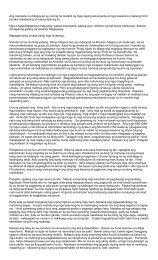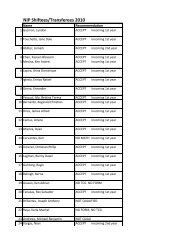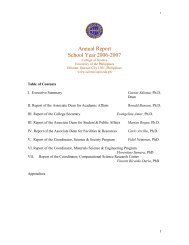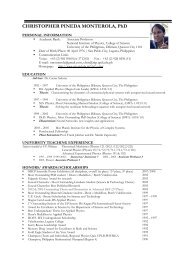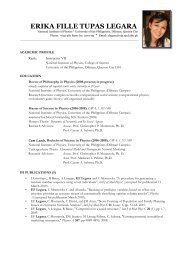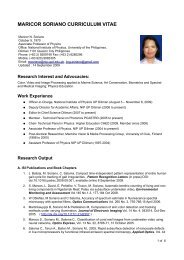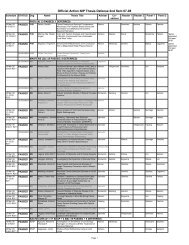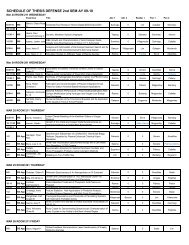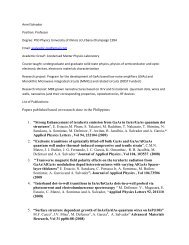NIP REPORT January 2006- May 2007 - The UP College of Science ...
NIP REPORT January 2006- May 2007 - The UP College of Science ...
NIP REPORT January 2006- May 2007 - The UP College of Science ...
You also want an ePaper? Increase the reach of your titles
YUMPU automatically turns print PDFs into web optimized ePapers that Google loves.
Title: Complexity in Competitive Populations<br />
Duration: <strong>January</strong> to December <strong>2006</strong><br />
Amount: PhP 36,000.00<br />
i. Dr. Cristine Villagonzalo<br />
Title: Modeling <strong>of</strong> TwoDimensional Electron Gases' <strong>The</strong>rmodynamics<br />
Properties in the Fractional Quantum Hall Regime<br />
Duration: <strong>January</strong> to December <strong>2006</strong><br />
Amount: PhP 36,000.00<br />
Part II. Summary <strong>of</strong> Past and Ongoing Research Projects<br />
<strong>The</strong> physics <strong>of</strong> macroscopic and microscopic systems from bulk solids and living organisms to atoms and<br />
molecules are dictated by their structure and the dynamics <strong>of</strong> their constituent parts. Understanding these<br />
underlying principles through theoretical and computational methods is the<br />
research thrust <strong>of</strong> the Structure and Dynamics Group.<br />
I. <strong>The</strong>oretical and Computational Physics<br />
A. Penna Model [Dr. Banzon]<br />
We started investigations on a population dynamics model that yields a Gompertzian age<br />
structure distribution -<br />
the Penna Model. It is a model that conforms to the mutation accumulation theory <strong>of</strong> aging. We s<br />
howed that a Penna bitstring model with only 8bits<br />
exhibits the same chaotic properties as that <strong>of</strong> the original 32bit model.[Nombres]<br />
A variant implementation <strong>of</strong> the model was also investigated that which applied the so<br />
called Verhulst factor (to account for the influence <strong>of</strong> the environmental carrying capacity)<br />
only to newborns (VB), as opposed to all ages in the original model. This implementation<br />
takes into account the idea that older individuals are able to adapt to the environment. It was<br />
found that it displays a greater degree <strong>of</strong> chaos compared to the original (VA)<br />
implementation. Also, the effective carrying capacity is explicitly defined only for the age at<br />
which the Verhulst factor is applied.[Nombres, Beech]<br />
It was noted that the newer, biologically more acceptable implementation (VB) does not<br />
yield a Gompertzian age structure. <strong>The</strong> nonGompertzian distribution was accounted for by<br />
an observed time dependence <strong>of</strong> the distribution with a shortterm periodicity. [Beech]<br />
Intraspecific competition was simulated for different Penna parameters. It was found that in<br />
general, the preferred population exhibits less fluctuation in its timeseries. [Beech]<br />
<strong>The</strong> degree <strong>of</strong> complexity associated with the resulting timeseries for a population was<br />
estimated using the embedding dimension. [Mandingiado, Ibo]<br />
A study was made to find a correlation between the embedding dimension and the<br />
competitiveness <strong>of</strong> a population. [Mandingiado]<br />
67



